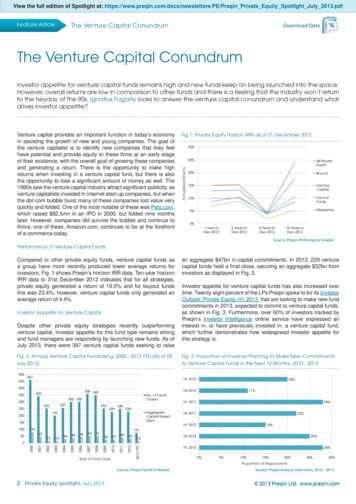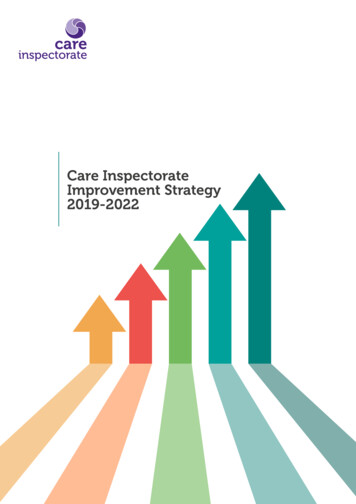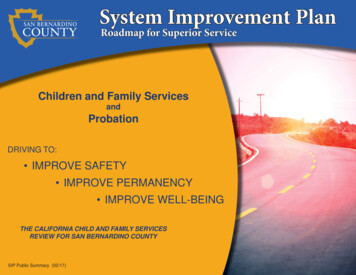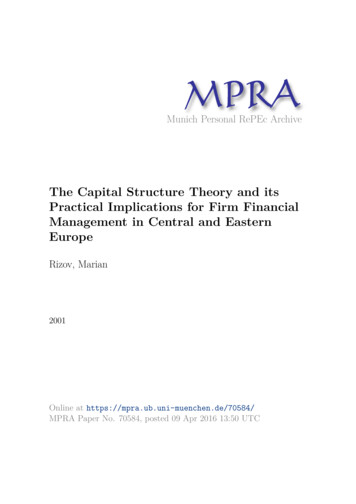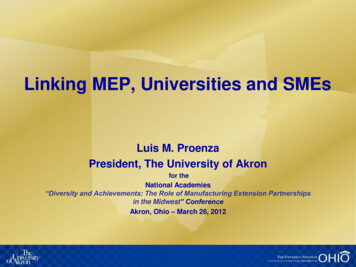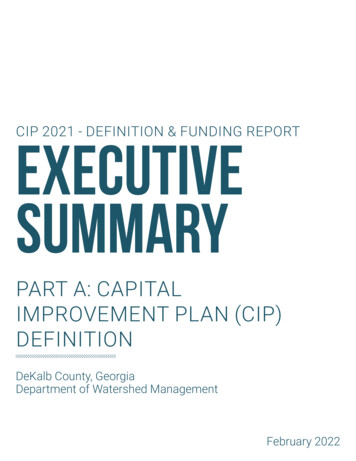
Transcription
CIP 2021 - DEFINITION & FUNDING REPORTexecutivesummaryPART A: CAPITALIMPROVEMENT PLAN (CIP)DEFINITIONDeKalb County, GeorgiaDepartment of Watershed ManagementFebruary 2022
DEKALB COUNTYDWM CIP 2021OverviewThis two-part Executive Summary defines the spending andfunding plans for the program.On February 23, 2021, the DeKalb County Board ofCommissioners approved a new CIP program for 20212030 (CIP 2021). This visionary 10-year, 2.4 billion (in 2021dollars) program will invest in and maintain the water andwastewater infrastructure vital to all County residents andbusinesses. CIP 2021 represents a new day for DeKalbCounty and has been developed using best-practiceapproaches and state-of-the-art hydraulic modeling, masterplanning, and project prioritization techniques.Part A: CIP DefinitionPart B: CIP Approval and FundingSummarizes the spending planfor CIP 2021 and describes thesteps in the program definitionand delivery lifecycle, whichinclude identifying, prioritizing,approving, and delivering CIPprojects.Summarizes the funding planfor CIP 2021 and describesactions to maximize revenues,minimize expenses, supportcustomers in need, and reducethe cost of borrowing.spending planbackgroundSpend SummaryHistorical overviewProgram LifecycleOutcomes: Balancingsystem needsThe County developed CIP 2021 through a thorough and transparentprocess involving frequent reports and presentations to the Board ofCommissioners. This Executive Summary highlights key information anddecisions from these touchpoints. A full archive of public materials canbe accessed at this link: LINK TO COME.PAGE 2CIP 2021 // EXECUTIVE SUMMARY PART A – CIP DEFINITIONcip 2021 benefitsfunding planBackgroundrevenue optimizationProcessdecrease operating costsincrease revenue &Assist those in needoutcomes: revenueoptimizationSustainable SystemReplacementDEKALB COUNTY DEPARTMENT OF WATERSHED MANAGEMENTPAGE 3
DEKALB COUNTYDWM CIP 2021CIP Definition BackgroundDeKalb County, Georgia, formed in 1822, has providedcentralized, county-wide water and wastewater servicessince 1942 when officials established the Department ofWatershed Management (DWM). Today DWM develops,operates, and maintains an estimated 6,000 miles of pipethroughout the County’s water distribution and wastewatercollection systems. In addition to this undergroundinfrastructure, DWM’s assets include the Scott Candler WaterTreatment Plant, the Snapfinger and Pole Bridge AdvancedWastewater Treatment Facilities, and some City of Atlantafacilities.The County has made substantial investments in capitalprojects to maintain and further develop these systems.In 2010, DWM created a Capital Improvement Plan (CIP2010) to deliver these projects through a consistent andwell-documented approach. Prior to 2017, neglect andmismanagement caused DWM to miss its delivery targetsfor the program, but new leadership stepped up in 2017 toaccelerate projects and drive the CIP to completion. As CIP2010 nears completion, DWM has drawn on best practicehydraulic modeling and master planning techniques toanalyze, prioritize, and fund investments that are still criticallyneeded. This work has culminated in CIP 2021—a newcapital program that will enable the County to effectively andresponsibly deliver these projects through 2030.PAGE 4CIP 2021 // EXECUTIVE SUMMARY PART A – CIP DEFINITIONCIP UPDATES, COMMUNITYMEETING RECORDINGS,AND WATER SAFETY VIDEOSCAN BE FOUND ON DEKALBCOUNTY’S WEBSITE ANDDEKALB WATERSHED’SYOUTUBE CHANNELDEKALB COUNTY DEPARTMENT OF WATERSHED MANAGEMENTPAGE 5
CIP 2021 SPEND SUMMARY 2.4B 2.4 Billion Planned SpendDEKALB COUNTYDWM CIP 2021CIP 2021 is a 2.4 billion (in 2021 dollars) investment in maintaining and developing water andwastewater infrastructure in DeKalb County. Proposed CIP 2021 investments are summarizedin the spend categories below.Reoccurring annual costsSOURCE WATER23%RAW WATER COLLECTED FROMTHE CHATTAHOOCHEE RIVERWater TreatmentWATER TREATED TOPOTABLE STANDARDSAT THE SCWTPReoccurring payments and projects make up 23 percent of CIP 2021. Intergovernmental Agreements (IGAs)are the largest component of reoccurring costs and include payments to the City of Atlanta to treat roughlyhalf of the County’s wastewater load and partnerships with the Georgia Department of Transportation (GDOT)to coordinate infrastructure upgrades beneath roadway projects. This category also includes annual andemergency contracts to address unforeseen needs to maintain aging infrastructure. These contracts arebased on bid tabulations, which enable projects to be priced based on a pre-agreed schedule of values.Water Treatment4%As DeKalb County is served by a single water treatment plant—the Scott Candler Water Treatment Plant(SCWTP)—CIP 2021 includes water treatment investments designed to improve the resilience of this vitalfacility. SCWTP was recently upgraded and remains a state-of-the-art facility, translating to watertreatment having the lowest planned expenditure (4 percent) among CIP 2021 spend categories.Water DistributionWater DistributionPOTABLE WATER DELIVEREDWastewater CollectionWastewater TreatmentPAGE 6WASTEWATERCOLLECTED BY THESANITARY SEWERSYSTEMWASTEWATER TREATED TOPERMIT-REQUIRED LEVELS31%Accounting for 31 percent of CIP 2021, water distribution investments will address several pressing needs:replacing aging and issue-prone pipes and increasing system capacity and resilience. DWM is usingsophisticated hydraulic models to better understand the condition of its assets system-wide and prioritize themost critical investments, including the 1,000 miles of pipe that has aged past its planned service life.Wastewater Collection37%At 37 percent, wastewater collection projects make up the largest spend category in CIP 2021. Most of theseprojects respond to the Consent Decree (CD) the County entered into in 2011{link} and include rehabilitatingand up-sizing wastewater collection assets to bring the system into CD compliance. The largest investmentsaddress capacity issues in major trunk sewers through up-sizing and building relief sewers and storageinfrastructure. These capacity projects are needed urgently, especially in the Snapfinger Basin.Wastewater Treatment5%CIP 2021 // EXECUTIVE SUMMARY PART A – CIP DEFINITIONDeKalb County has two wastewater treatment facilities: Snapfinger {link} and Pole Bridge. Following majorinvestments at the Snapfinger Plant in CIP 2010, only about 5 percent of CIP 2021 will be required forwastewater treatment upgrades. Investments include projects to complete the Snapfinger Plant expansionand targeted improvements at Pole Bridge, which remains adequately sized for its demands.DEKALB COUNTY DEPARTMENT OF WATERSHED MANAGEMENTPAGE 7
Historical OverviewFORMATION, DEVELOPMENT, AND PERIOD OF NEGLECTAND MISMANAGEMENTThe County’s early investments in water and wastewatersystems helped enable its surge in growth from the 1940sthrough the 1970s. During this period, the population morethan quadrupled and DeKalb County emerged as the secondmost populous county in Georgia.As population approached 700,000 around 1980, neglectand mismanagement began to adversely affect the County’swater and wastewater systems. Substantial investment wentinto upgrading treatment plants into state-of-the-art facilities,but underground pipes and sewers were not properlymaintained and developed. Failures to maintain aginginfrastructure (some pipes dating back over 100 years) andplan for future needs became evident through an increasingnumber of wastewater spills that damaged the environment,threatened public health, and led to litigation with the federaland state governments.In 2011, the County reached a Clean Water Act settlementin the form of a Consent Decree (CD) with the U.S. EPA andGeorgia Department of Natural Resources EnvironmentalProtection Division. DWM implemented CIP 2010 toexecute construction required under the CD, but furtherdelays—exemplified by the County’s failure to hire and onboard CD and CIP Program Managers until 2014 and 2015(respectively)—led to only 27 percent of the five-year programbeing completed through 2016.PAGE 8CIP 2021 // EXECUTIVE SUMMARY PART A – CIP DEFINITIONDEKALB COUNTYDWM CIP 202118221940-1970DeKalb County isformedPopulation surges. Asinfrastructure expandsrapidly, the County’spopulation more thanquadruples and DeKalbCounty emerges asGeorgia’s second largestcounty.1940General Motorslocates theirnew automobilemanufacturingplant in Doraville19421980County forms DWMto provide potablewater distribution andwastewater managementservices county-widePopulation approaches700,000. County waterand wastewater systemsenter a period of neglectand mismanagement.201120152016CIP 2010 developedto execute projectsarising from theConsent DecreeCD and CIPprogrammanagementteam broughton boardCIP 2010only 27 percentcomplete20202020We’re going to go all acrossthis county and get the jobdone, but you can’t undo 40years of neglect in three years.CIP 2010completed with afour-fold increasein the annual rateof project delivery27%85%Article in the AJC, March 12, 2020DEKALB COUNTY DEPARTMENT OF WATERSHED MANAGEMENTPAGE 9
TURNING THE CORNERA pivot in 2017 after years of missed opportunityIn January 2017, Michael L. Thurmond was sworn in as theCounty’s Chief Executive Officer (CEO) and the County’sBoard of Commissioners (Board) was fully constitutedfollowing years with vacant seats. Recognizing that boththe CD and CIP 2010 programs were not progressingquickly enough, the new leadership commissioned a rootcause analysis in 2018. This analysis revealed that theslow progress was caused by political interference in DWMoperations, inadequate oversight, allegations of corruptionand favoritism, and lack of transparency.The CEO and Board immediately pursued aggressivechanges to DWM leadership and culture, resulting in rapidimprovements—since this pivot, 756 million of key CIPinvestments have been completed.A NEW DAYCEO Thurmond declared a “New Day” of accountability andproductivity to rectify the issues caused by historical neglectand mismanagement. Under new leadership, DWM has madegreat strides including:Investing in best practice tools for infrastructure planning such ascomputer-based hydraulic models for both the water delivery andwastewater collection systemsDeveloping a detailed Water & Wastewater Master Plan through 2050Improving project delivery processes and developing a ProgramManagement Plan (PMP). These efforts resulted in a four-fold increasein the value of work completed in 2019 compared to 2015. DWM’s projectdelivery capability is now at the levels needed to implement CIP 2021.Launched the New Day Project to identify and address the root causes ofbilling issues, resulting in the upgrade or replacement of nearly 100,000meters and beginning the process to implement a new Utility CustomerBilling System.PAGE 10CIP 2021 // EXECUTIVE SUMMARY PART A – CIP DEFINITIONDEKALB COUNTYDWM CIP 2021 237MM 201MM 179MM 139MM 63MMAnnual spends of 50mm per year20102011DeKalb Countyapproves initialdraft CIP2012201320142015Effectivestart dateof the CIP20162017201820192020New County leadershipin place and pivot toNew Day“We did not create these challenges they have evolved over decades, but wemust, now in this CIP horizon, begin thework to solve them.”Michael L. Thurmond, CEODEKALB COUNTY DEPARTMENT OF WATERSHED MANAGEMENTPAGE 11
DEKALB COUNTYDWM CIP 2021CAPITAL IMPROVEMENT PLANPROGRAM LIFECYCLEDWM has developed and documented new processes andprocedures for the CIP program lifecycle—from initial projectdevelopment through prioritization, approval, funding, anddelivery.STEP 3 PRIORITIZATION Each proposed CIP project isscored by the technical teamthrough a multi-criteria analysisand subsequently prioritized An Executive Committee performsfinal review and approval ofproject scores and rankingsSTEP 5 DELIVERY As CIP projects take multipleyears to progress through delivery,an annual prioritization processis completed to align plans withthe County’s changing needs andfunding capacity CIP projects are delivered throughthe project lifecycle processdocumented in the ProgramManagement Plan (PMP). Stepsinclude planning, design, andconstruction.STEP 1 IDENTIFICATION CIP projects identified throughthe Master Planning process Operations team identifies projectsthrough system failures, citizencomplaints, regulatory requirements,and asset management processStep 1IdentificationStep 3PrioritizationStep 5Delivery Deferred projects, IGA changes,and other sourcesStep 2InitiationSTEP 2 INITIATION Determine if proposed project qualifiesas a CIP project Prepare, approve, and submit a ProjectInitiation Form for inclusion in theMaster Schedule and Program BudgetPAGE 12CIP 2021 // EXECUTIVE SUMMARY PART A – CIP DEFINITIONStep 4Approval & FundingSTEP 4 APPROVAL & FUNDING Governing authority reviewsand approves the CIP programand its funding planDEKALB COUNTY DEPARTMENT OF WATERSHED MANAGEMENTPAGE 13
DEKALB COUNTYDWM CIP 202154321STEP 1: IDENTIFICATIONSTEP 2: PROJECT INITIATIONUsing newly developed computer-based hydraulicmodels, DWM can monitor water and wastewater systemperformance in real-time to identify and troubleshoot issues.The detailed information these models provide has enabledDWM to complete its first ever Water and Wastewater MasterPlans. These plans are milestone achievements that supportthe community’s vision for sustained growth and prosperityand align with the County’s economic development plans.They establish responsible operational processes andfinancing practices that are guiding DWM as it develops andimplements system policies, capital projects, and servicestrategies.Once potential projects are identified—either originatingfrom Master Plans or arising from operational needs—DWMevaluates whether each proposed project qualifies as anappropriate investment to include in the CIP. DWM officialscomplete a common project sheet (i.e., initiation form)that describes the scope of work and provides informationnecessary to determine if the project is, in fact, a CIP project(as opposed to an operational cost). Based on this initialevaluation, some projects will drop out of considerationfor CIP 2021, although they may be funded through otherinitiatives.To develop the Master Plans, DWM drew heavily on bothhydraulic modeling software and stakeholder engagement.Hydraulic models identified future service scenarios basedon projected population and employment levels through 2050and evaluated the costs and benefits of each alternative. TheCounty validated and refined these options with input fromstakeholders.Through these efforts, DWM determined which capitalprojects would be needed between today and 2050, includingcritical (2025), short-term (2030), mid-term (2040), andlong-term (2050) projects. The Department also used thisinformation and input to craft high-level service strategiesthrough 2070.PAGE 14CIP 2021 // EXECUTIVE SUMMARY PART A – CIP DEFINITIONDEKALB COUNTY DEPARTMENT OF WATERSHED MANAGEMENTPAGE 15
DEKALB COUNTYDWM CIP 202154321DWM used a team-based, multi-criteria analysis approach toprioritize CIP 2021 projects. This best practice method, whichis both defensible and reproducible, is used by leading globalorganizations to rank order their investments, such as for theWorld Bank’s Infrastructure Prioritization Framework and theU.S. EPA’s Integrated Planning Framework.DWM used the prioritization framework to analyze all CIPprojects identified in Step 2 and determine which could beafforded. Among these projects, DWM advanced the top80 percent to be funded. Forty-four are improvements tothe water distribution network and 105 are upgrades to thewastewater management network. The prioritization processis thoroughly documented in Chapter 02 of the CIP ProgramManagement Plan.PAGE 16CIP 2021 // EXECUTIVE SUMMARY PART A – CIP DEFINITIONLife Extension of Asset5%Concurrence w/ Other CIP Projects5%Water Quality / Surface Water Quality3%Reduction of Operational Cost5%Cost Recovery5%Employment (More Jobs)3%lcinaancenna FiiFSystem Tightening3%Public Health & Safety15%Impacts to NaturalResources3%Energy Efficiency LowerCarbon Footprint6%Quality of Life / CustomerSatisfaction9%Economic Growth /Development9%tel Sl Snta tame enSocial& Environ nmSocial & EnviroTeam-based, multi-criteria analysis solicits input fromstakeholders to systematically evaluate (and periodicallyreevaluate) competing priorities against a set of agreedupon prioritization criteria. For CIP 2021, DWM has identifieda broad set of factors against which to assess projects,ranging from compliance requirements to financial impactsto social and environmental benefits. DWM engages teamswith a diverse array of perspectives to assess how projectsperform on these criteria. The Master Plans and hydraulicmodels provide a robust base of evidence for these teams todraw from when prioritizing investments.Prioritization framework with factors and criteria weightsComComplianceplianceSTEP 3: PRIORITIZATIONRegulatoryCompliance15%tewarw a dsrdshiphipDEKALB COUNTY DEPARTMENT OF WATERSHED MANAGEMENTResilience15%PAGE 17
DEKALB COUNTYDWM CIP 2021STEP 4: APPROVAL AND FUNDING54321As new CIP projects are identified and prioritized, DWM andDeKalb County Finance work together to develop detailedfunding plans. These plans help make sure DWM hassufficient funds to support both its operating costs and CIPexpenditures. Plans may be updated to align with evolvingneeds, such as when the number of projects included in theCIP is refined to match available funds or when additionalfunding is secured to support additional projects.The Funding Plan required to support CIP 2021 is discussedin greater detail in Part B of this Executive Summary. LINK TOPART B HEREThe CIP 2021 delivery team has developed a suite of toolsand standard methods to help deliver projects on-budget,on-schedule, and with consistently high quality. One essentialresource is the Program Management Plan (PMP) DWMdeveloped in 2017, which documents standard operatingprocedures project managers and staff are expected tofollow when planning, designing, and constructing CIPprojects. The PMP contains detailed guidance on processesand workflows, as well as links to supporting tools such asforms and templates.PMP Chapters: Standard Operating ProceduresPMP01STEP 5: DELIVERYOnce capital projects are defined and funded, it is criticalthat project delivery conforms to the schedules and budgetsdefined in the CIP. One common issue many programs faceinvolves projects under-spending and generating excessfunds, which leads to negative arbitrage—a situation wherethe debtor pays full interest on a loan or bond despite theprincipal not being completely spent. The County estimates itincurred as much as 80 million in negative arbitrage due todelays in delivering CIP 2010.ProgramOrganization& GovernancePMP06Procurement &ContractManagementPMP11Cost & ScheduleManagementPAGE 18CIP 2021 // EXECUTIVE SUMMARY PART A – CIP alth &EnvironmentPMP12ReportingPMP03ProjectManagement- PlanningPMP08QualityManagementPMP13Document ControlPMP04ProjectManagement- DesignPMP09RiskManagementPMP05ProjectManagement- EstimatingDEKALB COUNTY DEPARTMENT OF WATERSHED MANAGEMENTPAGE 19
DEKALB COUNTYDWM CIP 2021OUTCOMES OF CIP DEFINITION:BALANCING SYSTEM NEEDSMajor Investment Area 1:Deliver Critical Water Distribution ProjectsDuring the past two decades, DWM channeled most of itscapital investment into large projects that updated andupgraded the County’s above-ground treatment facilities. Theseimprovements have positioned the County to provide cleandrinking water and reliable wastewater treatment services todayand meet the projected demands of the growing population.With these projects largely complete, DWM’s investment focusmust now transition to its below-ground water distributionand wastewater collection systems.In recent years, the number of water line breaks has grownto more than 1,000 annually (on average). Whether the breakoccurs on a small service line inconveniencing a few customersor on a major water main, such as the 2018 break near BufordHighway that resulted in a boil water advisory, neither isacceptable. Breaks result in financial losses for the County,drain maintenance resources, reduce system resilience, andoften lead to adverse social and environmental consequences.Buried infrastructure makes up 68 percent of CIP 2021project spending, highlighting how important it is to maintainthe unseen yet critical portions of the system. As theseunderground systems age, they are performing far below theirneeded capacity, resulting in relatively high levels of water loss,system failures, and sanitary wastewater spills.Water distribution system historical water main repairs1Deliver critical water distribution projects2Expand trunk sewer capacity to comply with CDDeKalb Water Distribution System Historical Water Main Repairs1,4001,200Water Main RepairsCIP 2021 will focus on two major areas of investment:SIGNS OF AN AGING AND UNDER-SIZED SYSTEM1,000800600400Note: 2021 total has been projectedbased on the year-to-date value of486 as of July 11, GE 20CIP 2021 // EXECUTIVE SUMMARY PART A – CIP DEFINITIONDEKALB COUNTY DEPARTMENT OF WATERSHED MANAGEMENTPAGE 21
DEKALB COUNTYDWM CIP 2021The increase in water distribution system failures resultsfrom two main causes: (1) aging pipelines and (2)excessive pressures on an under-sized system. CIP 2021investments will target these issues.REPLACING AGING PIPELINESThe County’s water distribution system includes roughly3,000 miles of water pipe. Around 215 miles of this pipeare reaching 70 years of age and require replacement.Also, by 2050, an estimated 1,745 miles of pipe will reach70 years of age or older if they are not replaced on a settimetable. To compound this challenge, many pipes aremade of less resilient materials with shorter life expectanciesthan ductile iron (the current industry standard). Theseoutdated materials include pre-stressed concrete pressurepipe (7 miles), asbestos cement (522 miles), and cast iron(820 miles). As an example of the County’s efforts, DWMreplaced seven miles of aging water pipes in the Druid Hillscommunity following water pressure problems in 2021.The City of Atlanta had originally installed these pipes in the1920s.Renewal and replacementof aging infrastructure has been the#1 issue facing the water industryfor eight years running*American Water Works Association, 2020Massive water loss and a boil water advisory resulted from a failed 48 inch-diameterwater main near Buford Highway in 2018 (photo from AJC, March 7, 2018)Miles of water pipe reaching 70 years old:Now (2020): 215 miles (install date 1950 or earlier)By 2030: 596 miles (install date 1960 or earlier)By 2040: 1290 miles (install date 1970 or earlier)By 2050: 1745 miles (install date 1980 or earlier)PAGE 22CIP 2021 // EXECUTIVE SUMMARY PART A – CIP DEFINITIONDEKALB COUNTY DEPARTMENT OF WATERSHED MANAGEMENTPAGE 23
DEKALB COUNTYDWM CIP 2021More water mains experiencing high pressure ( 150psi) than low pressure ( 40 psi). Two times as manyexperience very high pressure ( 200 psi).130 milesLength of water mains doubling the max pressurerecommended by Georgia EPD and ten other statestandards. This is four percent of the system.4%17 times130 miles with Very high Pressure ( 200 psi)37%New hydraulic models have revealed that the most significantchallenge facing the County’s water distribution system isits constrained transmission capacity. DWM’s outmodedpressure management approach and undersized deliverysystem mean that greater effort is required to push waterthrough the network—a situation that leads to excessivelyhigh pressure and compromises resilience. In fact, watermains experiencing high pressure ( 150 psi) make up around41 percent of the system and far exceed those with lowpressure.1,100 miles with High Pressure ( 150 psi)57%DeKalb Water Main System Pressure1,729 miles within target (40-150 PSI)2%UPGRADING THE SYSTEM TO REDUCE PRESSURESAND ADD RESILIENCY65 miles with Low Pressure ( 40 PSI)DeKalb County Water Master Plan targets a maximum pressure of 150 psi. GeorgiaEPD, along with 10 other state standards, recommend 100 psi maximum.PAGE 24CIP 2021 // EXECUTIVE SUMMARY PART A – CIP DEFINITIONDEKALB COUNTY DEPARTMENT OF WATERSHED MANAGEMENTPAGE 25
DEKALB COUNTYDWM CIP 2021PAGE 26Major Investment Area 2:Expand Trunk Sewer Capacity to meet Consent DecreeConsent Decree Requires Four Main Types of WastewaterSystem ImprovementsNEXT PHASE OF CONSENT DECREEby 2027.Having now successfully completed CIP 2010, the Countyhas negotiated a modification to the CD with the U.S. EPAand State of Georgia. A key change involves pivoting awayfrom projects that reduce inflow and infiltration into thesanitary system and toward investments that increase theflow capacity of major sewer trunk lines. A trunk sewer isa large-diameter line that receives wastewater flows fromtributary feeder branch lines (for DeKalb County, pipesranging from 30-72 inches wide are considered largediameter). As part of the CD modification, DWM will improvecapacity across 59 miles of trunk lines, focusing primarily inthe Snapfinger Basin.Rehab 133 miles of leaking pipesthrough trenchless technologies(where possible)Perform 1,600 point repairs oflocalized pipe failuresUpsize or replace 35 miles ofsmall diameter sewer pipeUpsize 45 miles of large diameter“trunk” sewersCIP 2021 // EXECUTIVE SUMMARY PART A – CIP DEFINITIONDEKALB COUNTY DEPARTMENT OF WATERSHED MANAGEMENTPAGE 27
DEKALB COUNTYDWM CIP 2021CIP 2021 Priority ProjectsCIP 2021 Water Projects *CIP 2021 Wastewater Projects *3% Rehabilitation and replacement of aging water storage tanks ( 61M)4% Upgrades at the Scott Candler Water Treatment Plant ( 104M)7% Construction of a 60-inch water transmission main ( 180M)DeKalb PlannedCounty PlannedWater ProjectsDeKalb CountyWater ProjectsAgingwatermainreplacementprojects( 413M)17%6%24%")285285285Trunk sewer capacity improvement projects ( 576M)DeKalb County Sewer Trunkline ProjectsDeKalb County SewerTrunkline ProjectsLEGENDWASTEWATER ter treatment plant upgrades. ( 135M)WASTEWATERTREATMENTCAPACITYPRIORITY FIXLISTPLANT UPGRADESEPA DESIGNATED PRIORITYCAPACITY PRIORITY FIX LISTAREAS (PASARP)SCOTT CANDLER WATERSCOTT CANDLERWATER PLANTTREATMENTTREATMENT PLANTWATER TANK REHABILITATION")WATER TANKREHABILITATION& REPLACEMENT& REPLACEMENT60” TRANSMISSION MAIN60” TRANSMISSIONMAINPHASEAPHASE ASCOTT BLVD. WATER MAINSCOTT BLVD. WATERMAINREPLACEMENTREPLACEMENTINTERSTATE HIGHWAYSINTERSTATE HIGHWAYSDESIGNATEDPRIORITYSEWER EPATRUNKLINE PROJECTSAREAS (PASARP)INTERSTATE HIGHWAYSSEWER TRUNK LINE PROJECTS285SEWER BASINSINTERSTATE HIGHWAYS285INTER-GOVERNMENTALSEWER EBRIDGE285858585SNAPFINGER8585858585*These projects representa substantial portion ofthe program budget. Theremaining budget will helpfund reoccurring annual costssuch as intergovernmentalagreements and emergencyrepair PAGE 28CIP 2021 // EXECUTIVE SUMMARY PART A – CIP DEFINITION10.5012Miles10.5012Miles34345DEKALB COUNTY DEPARTMENT OF WATERSHED MANAGEMENT500.51234PAGE 29
DEKALB COUNTYDWM CIP 2021cip 2021 BenefitsCIP 2021 will improve the often unseen water and wastewaterinfrastructure resulting in tangible benefits for DeKalb residentsand businesses and enhancing economic development.Modified Consent DecreeCounty leaders worked with state and federal officials to modify the CD.These changes enable the County to bank credits for work completed andthen build new connections to areas that have been capacity constrained.This means many historically underserved areas with capacity limits will nothave to wait until the CD ends to invest in development.Set the stage for equitable investmentSince 2017, businesses and residents have made 1,551 requests for sewerconnections. 384 are still pending.Sewer system capacity constraints have disproportionately affectedsouthern DeKalb County, limiting new investment in historicallydisadvantaged areas.CIP 2021 investments will make sure beneficial future development, suchas new housing and grocery stores, are no longer held back due to waterand sewer system limitations.Benefit our shared environmentCIP 2021 investments aim to provide clean, healthy drinking water to all residentsand drastically reduce the risk of wastewater infiltrating our natural amenities.Reducing sanitary sewer spills protects our water resources and enhances thewellbeing of our environment and community.Reducing water losses protects the health of our regional rivers.Facilitate smart developmentBy 2050, the population served by the system is projected to exceed one millionresidents. Also, businesses in DWM’s service area employ around 640,000 people(and growing).CIP 2021 projects will help DWM provide reliable and high-quality water andwastewater services to all residents, now and in the future.Planned growth means increased opportunities for business and employmentand an expanded tax base.Create new jobsCIP 2021 will create an estimated 4,200 jobs (direct, indirect, and induced) duringits 10-year lifespan.PAGE 30CIP 2021 // EXECUTIVE SUMMARY PART A – CIP DEFINITIONDEKALB COUNTY DEPARTMENT OF WATERSHED MANAGEMENTPAGE 31
CHIEF EXECUTIVE OFFICERMichael L. ThurmondBOARD OF COMMISSIONERSRobert Patrick, District 1Jeff Rader, District 2Larry Johnson, District 3Steve Bradshaw, District 4Mereda Davis Johnson, District 5Ted Terry, District 6Lorraine Cochran-Johnson, District 7South River, Georgia (photo from AJC)
Commissioners approved a new CIP program for 2021-2030 (CIP 2021). This visionary 10-year, 2.4 billion (in 2021 dollars) program will invest in and maintain the water and wastewater infrastructure vital to all County residents and businesses. CIP 2021 represents a new day for DeKalb County and has been developed using best-practice
